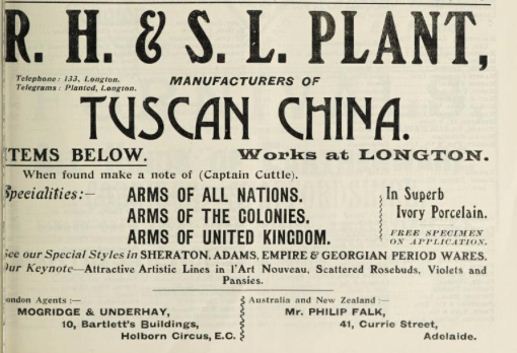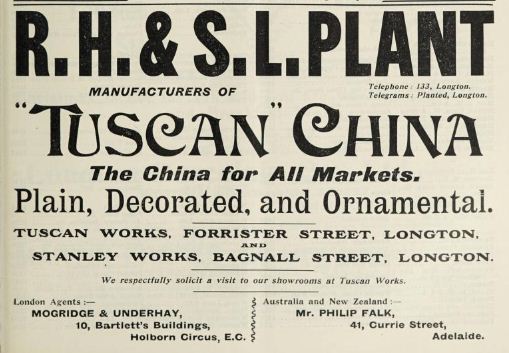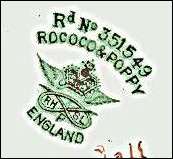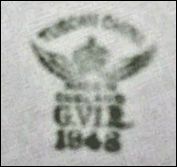![]()
|
R H & S L Plant |
Location and period of operation:
|
R H &
S L Plant |
Longton |
1898 |
1966 |
China manufacturer at the Tuscan Works, Longton (& from 1906 to 1910 at the Stanley Works) Stoke-on-Trent, England.
|
Formerly: R.H. Plant
[also amalgamated Plant Bros in c.1906]
 R.H. & S.L. Plant Manufacturers of Tuscan China Specialities:- Arms of all Nations, the Colonies, the United Kingdom The Pottery Gazette, July 1906 "Messrs. Plant are greatly extending the production of their Ivory Heraldic Porcelain. In addition, too, "Badge" ware has always been a special line with the firm, but in recent years they have given considerable attention to "Arms" ware - or heraldic ware - and have supplied a large number of well-modelled miniatures, and fancy shapes, embellished with the arms of counties, towns, &c. They have now made another departure, and are applying their enamelled heraldic devices to useful, as well as to ornimental and fancy pieces." March 1906 |
 R.H. & S.L. Plant Manufacturers of Tuscan China Tuscan Works, Forrister Street, Longton Stanley Works, Bagnall Street, Longton The Pottery Gazette, November 1906 This advert includes the Stanley Works - which were previously operated by Plant Bros. until their bankruptcy in early 1906. The business was amalgamated with R.H. & S.L. Plant |
This article originally appeared in a 1956 book 'British Potters and Pottery Today', is based mainly upon accounts provided mainly by the firms themselves.
R. H. and S. L. Plant Ltd., Tuscan China Works, Longton"Although the known history of R. H. and S. L. Plant Ltd. (makers of Tuscan China) extends only over the last ninety years or so, yet it is evident that ancestors of this potter family had been throwing pottery at Lane End (Longton) at least as early as the last half of the eighteenth century.
William Chaffers, pioneer writer on ceramics, in his Marks and Monograms of Pottery and Porcelain records the name of B. Plant, Lane End, as occurring on a jug in the form of a lioness; also a white glaze basket, made about 1780, in the possession of James Plant of Salford and a pair of lions inscribed 'Benjamin Plant, Lane End', in the possession of a Mr Hailstone.
To this evidence may be added two examples of the ware of this Benjamin, belonging to the present Managing Director of the firm. One is a quart stone-ware teapot, beautifully decorated with figures in relief, the other a spoon mould. The same gentleman has in his possession an old diary which belonged to the potter, inscribed 'Benjamin Plant – his book, 1775'.
Among the entries, some of them quaint, in this little volume there is one giving the average prices of meat at that time – veal 3d. a pound, lamb 6d. a pound, and pork 6˝d. a pound. But more germane to our subject are several receipts for coloured bodies (including yellow and black) and for glazes (including one for a deep violet colour).
There is unfortunately no record of where the factory stood, but it must have been at Lane End and the present makers of Tuscan China are proud to claim this eighteenth-century potter as progenitor of a long line of the Plant family, with whom they have at least a sentimental link.
Originally the newly established firm was in occupation of Carlisle Works (now derelict) at Longton, but over fifty years ago a move was made to the present site. The factory was named the Tuscan Works and the partner proprietors were R. H. Plant and his brother.
The business was formed into a limited company in 1915, still running under the aegis of the Plant family, with S. L. Plant and his son (F. S. Plant) directing the Sales Department, while the two brothers H. J. and A. E. Plant were in charge of the production side.
Under this family directorship, succeeded by a younger generation as time went on, the firm has flourished and the output improved in quality and quantity. At all times research has played an important part in the activities of the factory and it is no overstatement to say that now-a-days both the bodies and the glazes are as near to perfection as modern science and craftsmanship can achieve.
Two outstanding fruits of such intensive research have materially helped in its attaining this position. One was the discovery of a very fine body suitable for hotel ware, which owing to its strength and finish was named 'Metallised Hotel China'. The fracture-resisting strength of this body has been tested and found superior to all others, so that after a quarter of a century it still holds its own in the world markets. This body was the discovery of J. B. Clarke, one of the firm's finest Art Directors, who was a skilled chemist, and its introduction did much to relieve the situation caused at the time by the importation of foreign hotel wares.
The other notable event was the discovery of a very beautiful china body having a slightly pink shade, which was given the name of Peach Bloom. As it lends itself to particularly pleasing decorative schemes and colourings it is regarded as a great asset to the reputation of the firm.
Always much of the factory's prestige has depended upon the excellence of its art directive. Joshua Mellor, well known throughout the trade in the earlier years, was an outstanding designer and ultimately (as related elsewhere) he became a partner in the New Chelsea Porcelain Co., which was at one time owned by the Tuscan directors. He and his work inspired the younger men who succeeded to his position. Then there was J. B. Clarke, for over thirty years with the firm and William Slater, brother of John Slater of Doultons, who was with them in the late nineteenth century. All these have happily found worthy successors at the present day who contribute to the excellence and beauty of Tuscan China products. An entirely up-to-date factory, with gas fired tunnel kilns and two electric kilns contribute to the results. Improvements are still going on for, in the pottery industry, finality can never be reached."
- click for more details of the works -
Initials and names used on ware for identification:
RH & SL PLANT
RH & SL
P
PLANT
TUSCAN CHINA
the trade name
Tuscan China was
introduced in 1902 and nearly all marks from this
date incorporated the name along with the
characteristic 'wings'
Fungus Ware
ROYAL TUSCAN CHINA
(from 1966
onwards
as part of the Wedgwood Group)
METALLISED


Tuscan
China
Made in England
G VI R
1948
|
The mark shown indicates that the ware was produced for and supplied to the British Government; it was ultimately property of the Crown/Government, hence the GR-VI Cypher. This mark is there to distinguish the piece from being normal ‘utilitarian’ ware for public sale during the period surrounding the Second World War. RH & SL Plant (and others) were given government contracts throughout the late 1930s and into the 1940s (WWII) and produced canteen ware - most likely for the armed services. The year of manufacturer is generally included. |
click on the following for more information:-
Questions, comments, contributions? email: Steve Birks